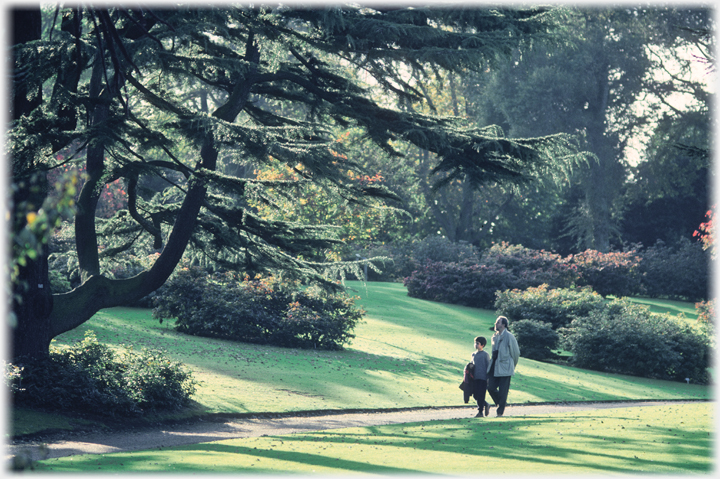 An autumn stroll in the 'Botanics'
The
Royal Edinburgh Botanic Gardens,
An autumn stroll in the 'Botanics'
The
Royal Edinburgh Botanic Gardens,
 affectionately known locally as the 'Botanics', extends to some 72 acres (28 ha) and was established on its present site in 1828. Originally it was founded near Holyrood Palace in 1670, in 1763 it was moved to Leith Walk to get away from the city's pollution. It has some 13 thousand growing species, plus over 3 million preserved specimens, making it one of the largest collections of plant material in the world.
affectionately known locally as the 'Botanics', extends to some 72 acres (28 ha) and was established on its present site in 1828. Originally it was founded near Holyrood Palace in 1670, in 1763 it was moved to Leith Walk to get away from the city's pollution. It has some 13 thousand growing species, plus over 3 million preserved specimens, making it one of the largest collections of plant material in the world.
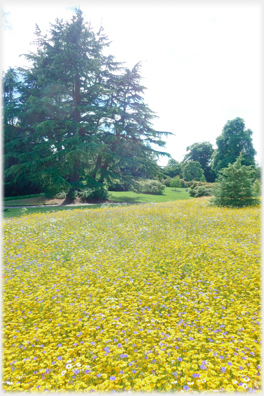 The tree from the top picture seen again some 30 years later. To its right are the rhododendrons of which more below
The tree from the top picture seen again some 30 years later. To its right are the rhododendrons of which more below
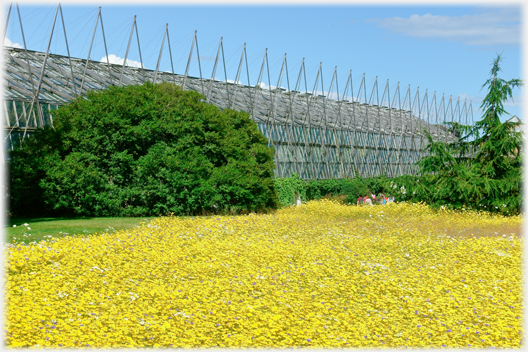 The main glass house was constructed in 1967 and is 420 (128m) feet long. It was built at the same time as the
Forth Road Bridge
The main glass house was constructed in 1967 and is 420 (128m) feet long. It was built at the same time as the
Forth Road Bridge
 and soil removed for the bridge building was used in it
and soil removed for the bridge building was used in it
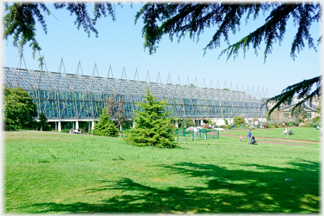 The Main Glass House in Spring. It was designed so that all the supports and frameworks were outside, leaving the inside uncluttered
The Main Glass House in Spring. It was designed so that all the supports and frameworks were outside, leaving the inside uncluttered
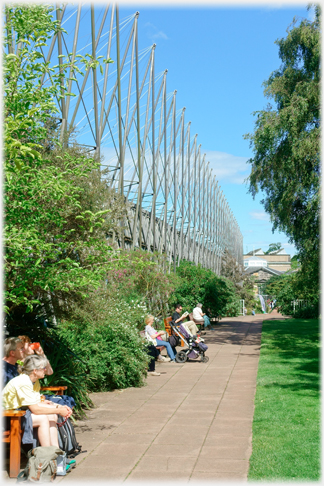 The facade of the Main Glass House with its walkway and seats
The facade of the Main Glass House with its walkway and seats
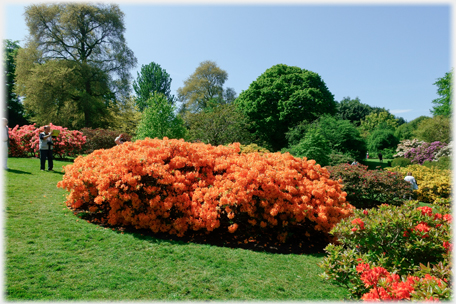 One of the rhododendron beds in Spring
One of the rhododendron beds in Spring
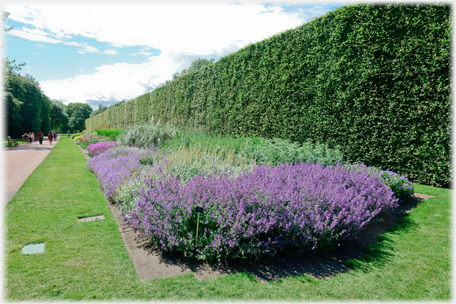 The herbaceous border is 165m long and is backed by a beech hedge over 100 years old
The herbaceous border is 165m long and is backed by a beech hedge over 100 years old
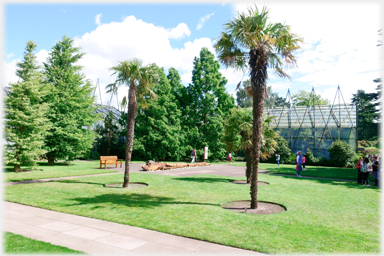 One of the 28 glasshouses is in the background, beyond palms that can cope with an Edinburgh winter
One of the 28 glasshouses is in the background, beyond palms that can cope with an Edinburgh winter
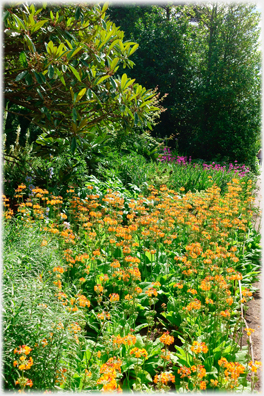 Primulas along a border
There is a range of 27 glasshouses situated behind the large main one that the public see, the first of these was built when the site was adopted in 1832 at a cost of £1,500. These are mostly devoted to experimentation and development and so are not open to the public.
Primulas along a border
There is a range of 27 glasshouses situated behind the large main one that the public see, the first of these was built when the site was adopted in 1832 at a cost of £1,500. These are mostly devoted to experimentation and development and so are not open to the public.
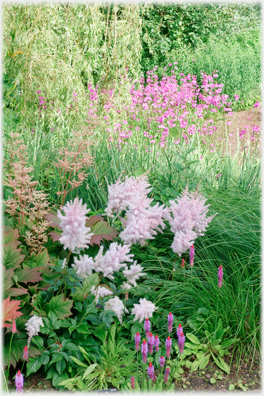 Astilbie and...
Astilbie and...
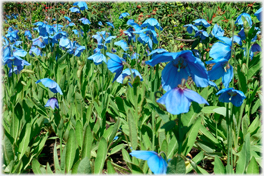 ...Mecanopsis two plants often found in Scotland, but rare in England
...Mecanopsis two plants often found in Scotland, but rare in England
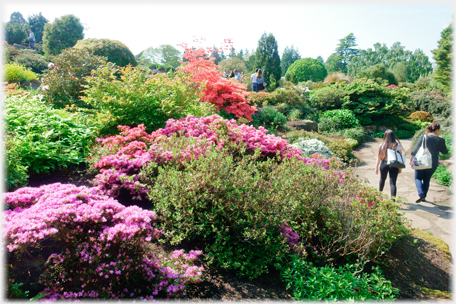 Azaleas in the rockery
Azaleas in the rockery
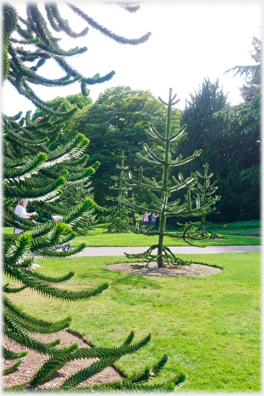 Monkey puzzle trees (Araucaria araucana)
Monkey puzzle trees (Araucaria araucana)
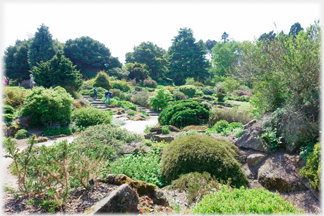 A general view of the Rockery
The Rock Garden was first introduced in 1871, at the time it was a novelty to plant alpines in rocks in this way. Now it is home to some 5,000 species.
A general view of the Rockery
The Rock Garden was first introduced in 1871, at the time it was a novelty to plant alpines in rocks in this way. Now it is home to some 5,000 species.
The most recent of many major innovations is the Chinese Hillside which was started in 1993. The Botanic Gardens have more living species of Chinese plant than anywhere outside China.
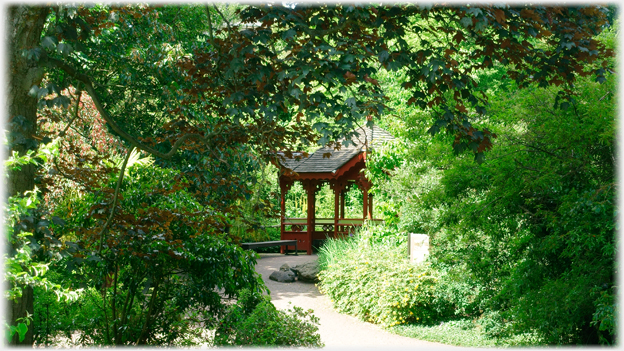 At the foot of the Chinese Hillside this pavilion sits beside a pool
At the foot of the Chinese Hillside this pavilion sits beside a pool
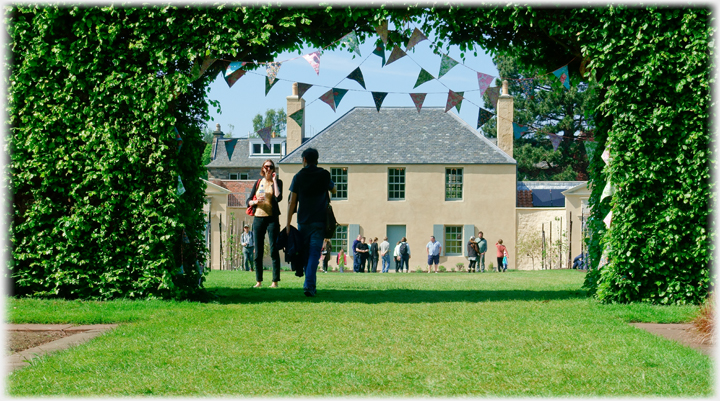 The
'Botanic Cottage'
The
'Botanic Cottage'
 is new. Well new to its present position. It is the original head gardener's cottage from when the botanic gardens were in the area that is now the middle of Leith Walk. In 1823, when the gardens came to their present position, the cottage was left behind. This year (2016) after painstaking dismantlement, relocation and restoration the cottage is now again in the Botanic Gardens. It was designed by John Adam and James Craig
is new. Well new to its present position. It is the original head gardener's cottage from when the botanic gardens were in the area that is now the middle of Leith Walk. In 1823, when the gardens came to their present position, the cottage was left behind. This year (2016) after painstaking dismantlement, relocation and restoration the cottage is now again in the Botanic Gardens. It was designed by John Adam and James Craig
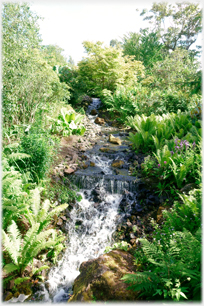 A cascade on the stream displaying plants which enjoy the water's edge
A cascade on the stream displaying plants which enjoy the water's edge
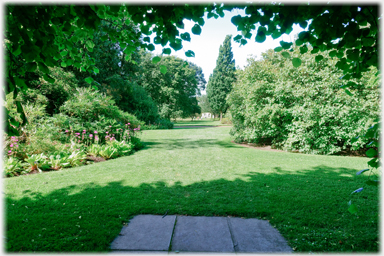 Main walk from Inverleith House to the newly positioned 'Botanic Cottage', the dot at the centre, in the distance
Main walk from Inverleith House to the newly positioned 'Botanic Cottage', the dot at the centre, in the distance
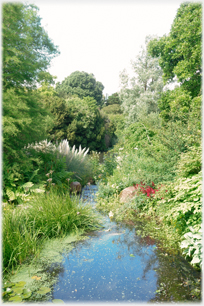 And stiller water for other species
In the 1820s the present gardens were developed on grounds originally belonging to Inverleith House, and the house itself was given to the country in 1877. In 1960 the house became the Scottish National Gallery of Modern Art. The pleasure of having such a collection in the gardens was immense, but sadly in 1984 the Modern Art Gallery was moved to its present home in John Watson's for reasons of space.
And stiller water for other species
In the 1820s the present gardens were developed on grounds originally belonging to Inverleith House, and the house itself was given to the country in 1877. In 1960 the house became the Scottish National Gallery of Modern Art. The pleasure of having such a collection in the gardens was immense, but sadly in 1984 the Modern Art Gallery was moved to its present home in John Watson's for reasons of space.
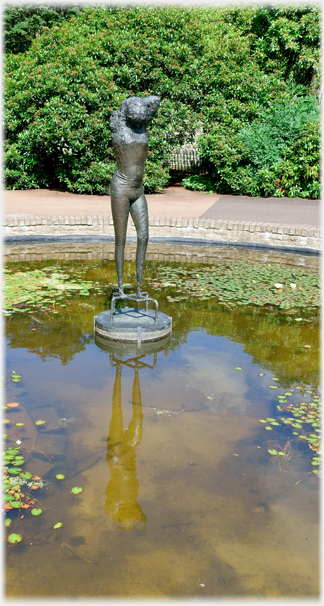 This sculpture by Reg Butler - Girl - was purchased by the then gallery as one of its first acquisitions
This sculpture by Reg Butler - Girl - was purchased by the then gallery as one of its first acquisitions
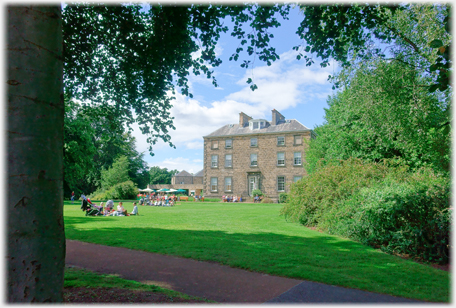 The south side of Inverleith House (above) has a magnificent panoramic view of Edinburgh (below)
The south side of Inverleith House (above) has a magnificent panoramic view of Edinburgh (below)
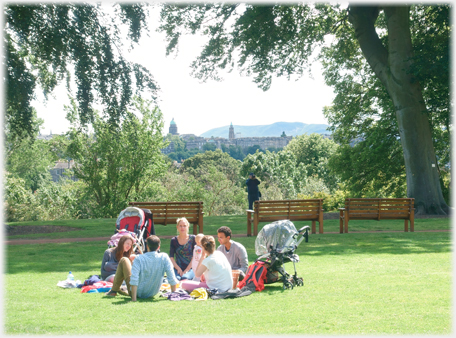 The view from the lawns in front of Inverlieth House sweeps from the Lothian Hills (seen here), across the Castle, to Arthur's Seat (behind the trees to the left)
The view from the lawns in front of Inverlieth House sweeps from the Lothian Hills (seen here), across the Castle, to Arthur's Seat (behind the trees to the left)
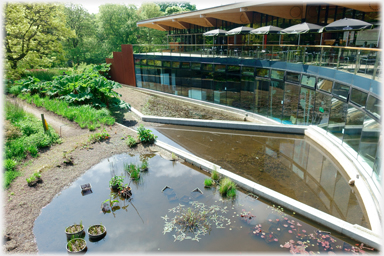 Ponds at the rear of the new John Hope building
Ponds at the rear of the new John Hope building
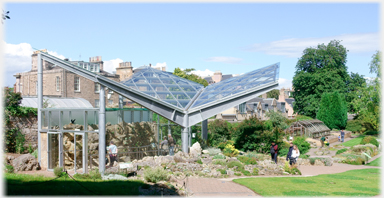 The new alpine 'house' attempts to mitigate something of the Scottish climate in defence of plants from drier climes
The new alpine 'house' attempts to mitigate something of the Scottish climate in defence of plants from drier climes
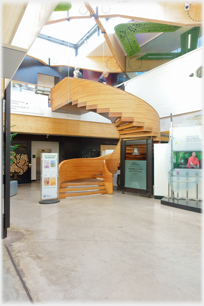 The stairway up to the restaurant in the John Hope Building
The new West gateway is named after John Hope who lived from 1725 till 1786 and was the keeper of the gardens
The stairway up to the restaurant in the John Hope Building
The new West gateway is named after John Hope who lived from 1725 till 1786 and was the keeper of the gardens
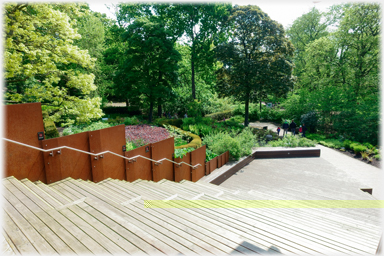 The outside stair at the rear of the new building which descends to a performance area
from 1761 to 1786 and professor of botany at Edinburgh University. The gateway was opened in 2009.
The outside stair at the rear of the new building which descends to a performance area
from 1761 to 1786 and professor of botany at Edinburgh University. The gateway was opened in 2009.
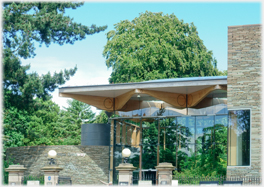 The John Hope West Gate
The John Hope West Gate
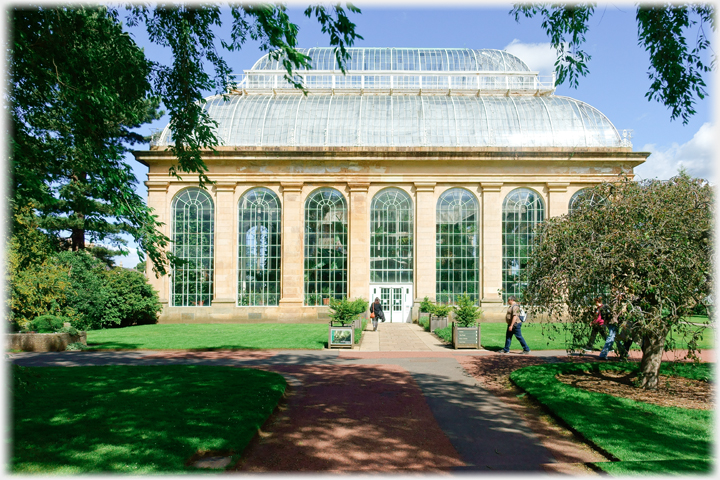 The Temperate Palm House was built in 1858 to a design by Robert Matheson, at 72 ft (22 m) it was the tallest building of its type at the time
The next page
goes to another of the four gardens which make up the Royal Botanic Gardens. Logan Gardens are at the southernmost tip of Scotland, projecting into the sea and giving Logan a climate which can support many tropical plants.
The Temperate Palm House was built in 1858 to a design by Robert Matheson, at 72 ft (22 m) it was the tallest building of its type at the time
The next page
goes to another of the four gardens which make up the Royal Botanic Gardens. Logan Gardens are at the southernmost tip of Scotland, projecting into the sea and giving Logan a climate which can support many tropical plants.
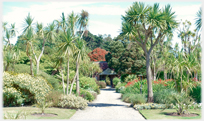

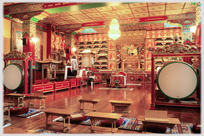 The last page had images from Samye Ling
The last page had images from Samye Ling
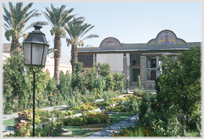 A page on Shiraz which shows a hot garden in snow
A page on Shiraz which shows a hot garden in snow
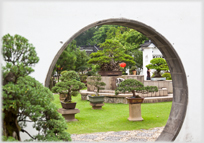 To a page on the Jurong Gardens in Singapore
To a page on the Jurong Gardens in Singapore
